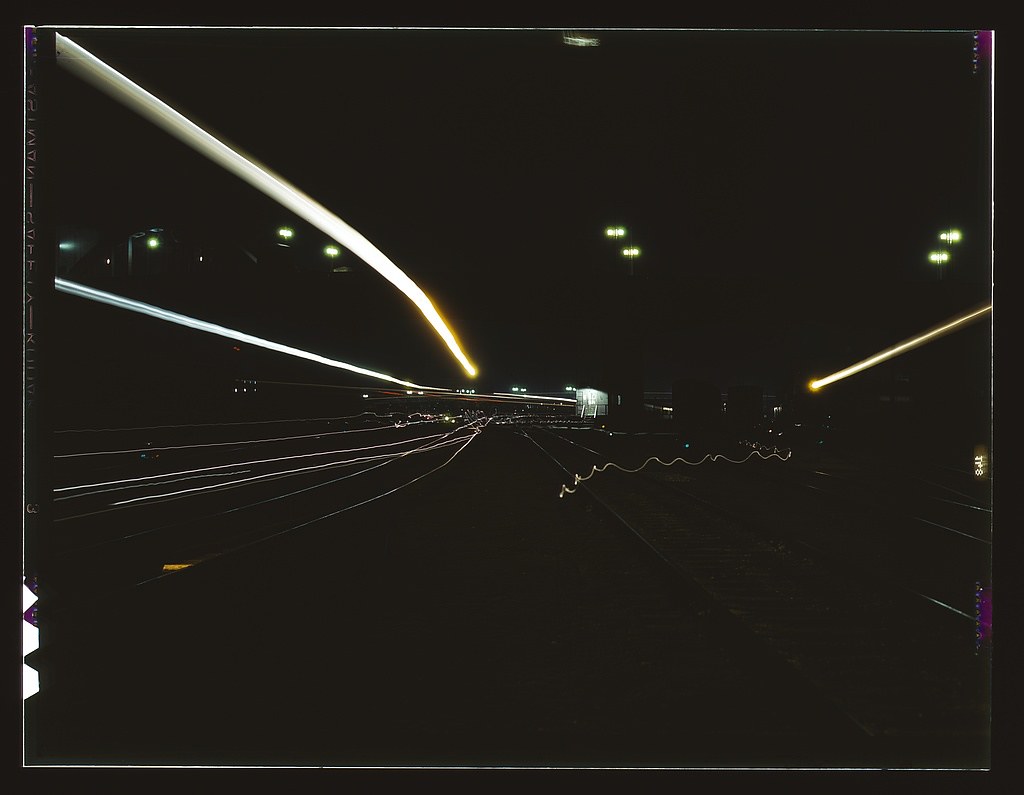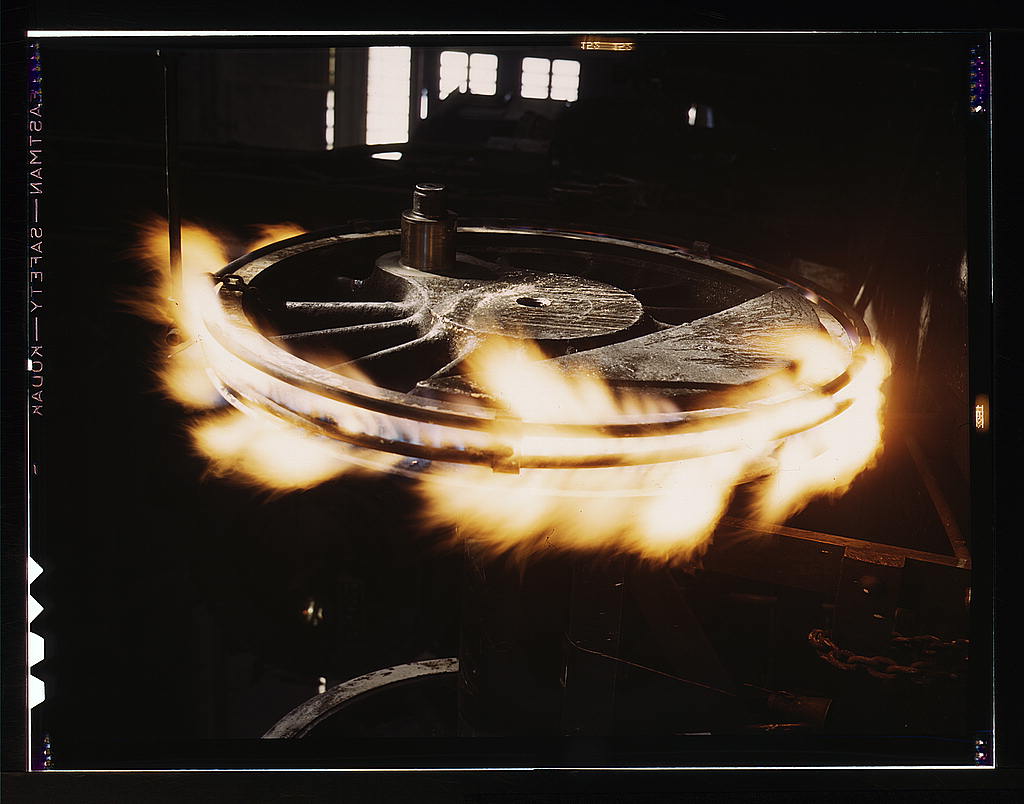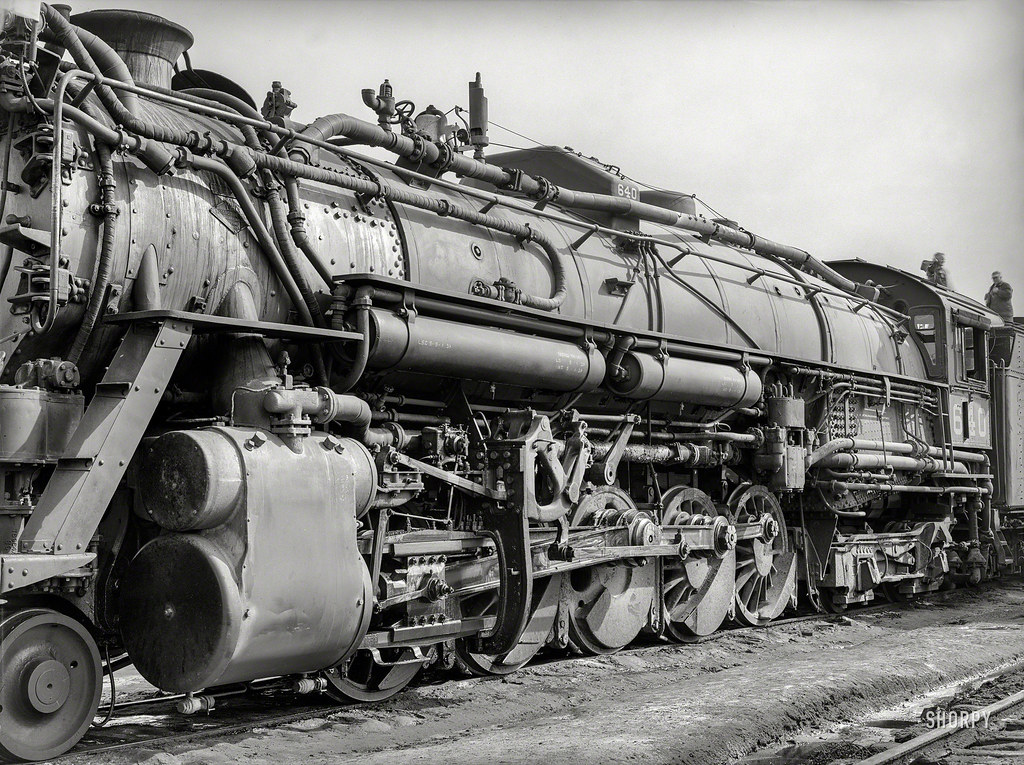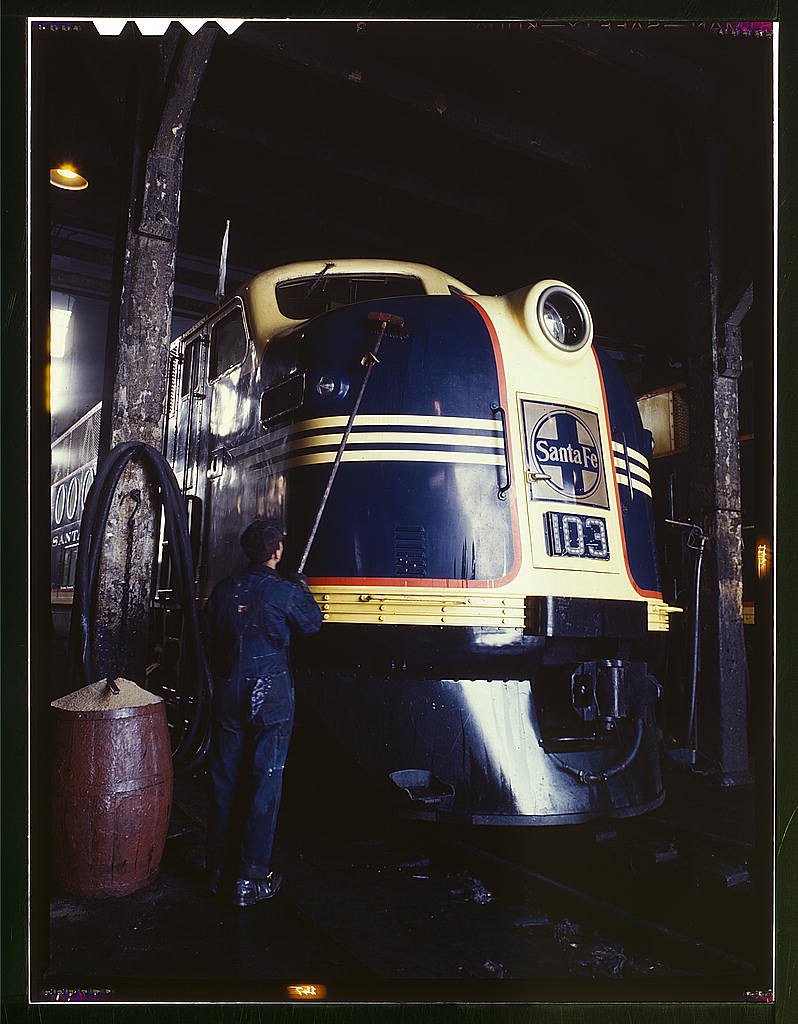#FSA Locomotives
Text

Tired ex-GCR 8k who went through WWI and is just trying to live a more peaceful life in a south american railway
96 notes
·
View notes
Video
Activity in the Santa Fe R.R. yard, Los Angeles, Calif. All switch lights, head lights and lamps have been shaded from above in accordance with blackout regulations. The heavy light streaks are caused by paths of locomotive headlights and the thin lines b by The Library of Congress
Via Flickr:
Delano, Jack,, 1914-1997,, photographer. Activity in the Santa Fe R.R. yard, Los Angeles, Calif. All switch lights, head lights and lamps have been shaded from above in accordance with blackout regulations. The heavy light streaks are caused by paths of locomotive headlights and the thin lines by lamps of switchmen working in the yard. Santa Fe R.R. trip 1943 March 1 transparency : color. Notes: 12002-3. Transfer from U.S. Office of War Information, 1944. Title from FSA or OWI agency caption. Subjects: Atchison, Topeka and Santa Fe Railroad World War, 1939-1945 Railroad shops & yards Night United States--California--Los Angeles Format: Transparencies--Color. Rights Info: No known restrictions on publication. Repository: Library of Congress, Prints and Photographs Division, Washington, D.C. 20540 USA, hdl.loc.gov/loc.pnp/pp.print Part Of: Farm Security Administration - Office of War Information color slides and transparencies collection (Library of Congress) (DLC) 93845501 General information about the FSA/OWI Color Photographs is available at hdl.loc.gov/loc.pnp/pp.fsac Higher resolution image is available (Persistent URL): hdl.loc.gov/loc.pnp/fsac.1a34703 Call Number: LC-USW36-693
1 note
·
View note
Text
Review of “Seashaken Houses”
As a teenager in the 90s, I was interested in lighthouses, and visited a couple (Hook Head and Mew Island) before they were automated. I think what I found appealing was the 19th Century technology, the neatness and definiteness of the constructions. Lighthouses are popular with the public for their ‘nautical gaiety’, although, as workplaces, they are solemn. If I had been in America, I might have studied NASA rockets instead. Irish lighthouses represented a relatively accessible, if anachronistic, form of high tech. So I think, when I read about them, that I was after a shot of technology, precision and good order, not gaiety. Looking back, I wonder now whether I was completely immune, though, to the main appeal of lighthouses, which is their civility. This quality is sometimes emphasized by wild surroundings, but it doesn’t have to be. The politeness and formality of a lighthouse stands out in any setting. In black and white photographs and section drawings, from old illustrated books, their solidity and precision appealed to something in my personality.
I’ve moved on from my lighthouse enthusiasm, but recently picked up Seashaken Houses: A Lighthouse History from Eddystone to Fastnet by Tom Nancollas. It’s an interesting book to me for a few reasons. Nancollas works in building conservation. He is a graduate in classical studies and a self-described antiquary: though in his mid 30s, he uses the letters FSA after his name. It will come as no surprise that he is a bit of a young fogey. The book is a selective history of the rock lighthouses of these islands from the perspective, primarily, of architectural history.
The first thing to note is that focusing on rock lighthouses is a bit like focusing on express locomotives or thoroughbred horses. These buildings form an elite category among lighthouses. Even more than the typical lighthouse, they are high-end engineering projects, on which money, attention, and craftsmanship was lavished. The first wave-washed towers were civil engineering marvels. As such, they are compatible with the values of the ancien régime: the marvellous rather than the uniform. Every rock lighthouse is a bespoke item, a custom job, consisting of thousands of precisely tailored stone blocks, dovetailed into the bedrock. These towers are notable for their symmetry and crystalline order.
After a couple of freakish and inadequate attempts which lasted only a few years, the design of rock lighthouses settled into a pattern. The archetype was the third Eddystone lighthouse, designed by John Smeaton. Constructed of granite blocks, it was a tapering circular tower with a lantern at the top. Smeaton’s tower established the compelling architectural image of a hollow, inhabited pinnacle of rock, almost completely unadorned. The development of a new building type is the most exciting event in architecture. It is to the representatives of this once new genre of tower that Nancollas devotes his book: Eddystone, Bell Rock, Haulbowline, Perch Rock, Wolf Rock, Eddystone (again), Bishop Rock, Fastnet.
As an antiquary, Nancollas comes to his subject with somewhat vague qualifications. He knows a bit about architectural history, though he is not an architect. He has a taste for authentic idioms, though he doesn’t pick up some of the most distinctive lighthouse terminology—wave-washed, for example. He is neither an engineer nor a seaman. People who like the book seem not to object to the gentlemanliness of his project. He is a personable narrator, and people seem inclined to entertain his pretensions to history writing, particularly the insinuation of his own experiences into the story. Though he can come across as a bit privileged, it would be a trap to conclude that due to having been well brought-up he must be an upper-class twit. He is temperamentally suited to recording what defines lighthouses from an architectural point of view: their civility, their good form.
So the book, even if it is, in truth, less a passion project than a vehicle for Nancollas’ writerly ambitions, is successful. He covers all the bases, as far as the architectural history of the buildings goes. I am not sure than he is so strong on placing the wave-washed towers into context. They exemplify the endlessly mysterious dictum “form follows function”. Nancollas doesn’t mention the slogan, and I don’t think he would perceive it as a mystery, so much as a glib banality.
The towers were machines and participants in a proliferating network of signalling and navigation. Cooped up inside, the keepers led dreary lives of unrelenting solitude, slaves to the machinery. What is missing in this world of duty and responsibility is a sense of exuberance or expansiveness. The engineering of any one of these towers may have been a virtuoso performance, but occupying them was not. Physically restricted to a small compass, the keepers could scarcely give free rein to any aspect of their personality, while, outside, the ungovernable sea did its own thing, day and night.
As a teenager I read, in a book about Scottish lighthouses, about a keeper who was studying mathematics in the evenings. This fact seemed resonant and stayed with me. In addition to possessing the circular symmetry of most lighthouses, the wave-washed towers reflect a complex, orderly process of assembly. The premeditated, scripted sequence of operations was a way to guarantee the unshakable soundness of the towers. This is a property which it shares with the 19th Century development of mathematical formalisms, intended to place mathematical proof on an unassailable foundation. But there is a more psychological relevance of mathematics to the life of a lighthouse keeper. Mathematics—reason’s dream—is a mental practice of domination, of control. The mathematician is always the wrangler, never the subdued, always the buttoner-up, never the buttonee. It is a form of agency which is available even in the most isolated and confined quarters, when one is “bounded in a nutshell”.
A preoccupation with fallibility infuses the whole operation of lighthouses. In the 1850s Michael Faraday remarked that “There is no human arrangement that requires more regularity and certainty of service than a lighthouse.” The seriousness of the task in hand justifies the omission of ornament. Foibles and fripperies are excluded. But from the architectural historian’s perspective, the 19th C towers still have some traces of politeness, some flourishes, some relics of old decency. Looking at them, it is easy to understand the spirit of Horatio Greenough’s statement—“In nakedness I behold the majesty of the essential instead of the trappings of pretension”. The order of the day is structural necessity, not ornamental contingency, forms that relate to the job of exhibiting a light high above the water rather than extemporized curlicues. In that sense, the towers obey the modernist logic of form following function. The philosophy of their design is an appeal to “fixed and unchangeable laws” and a dismissal of “eccentric opinions” (Laugier). It is an ambiguous perfection.
Nancollas doesn’t seem to appreciate the notion of modernism in this sense. He doesn’t use the term in a positive sense, except to remark, bizarrely, that an Irish Lights helicopter looks “reassuringly modern and functional”.
The structural integrity of the towers visited by the narrator is a prerequisite for the continuity of the service they provide. It is just one aspect of their reliability. In gentlemanly style, Nancollas suppresses the technicalities of the lights’ construction and operation. For example, he seems unaware that an ellipse has two unequal axes, and thus mangles a description of the geometrical definition of the shape of Wolf Rock’s tower. Lamenting the modernization of Bell Rock, he claims “it requires only a little ingenuity to let the old coexist with the new, even offshore.“ There is a risk, in avoiding technicalities, that the achievement becomes indistinct and dull, the account facile.
In the early days of mass production, the perfect precision of a machine’s construction was understood to mean perpetual reliability. We are less inclined to make this connection now—the possibility of human error in manufacturing has receded as a cause of failures, replaced by more exotic problems due to complexity and economic constraints. Little expense was spared in the construction of the rock lighthouses, and their designers were cautious and conservative in their technical specifications. It’s clear that this quality is part of their particular appeal. Studies suggest that the towers have a good chance of surviving future rough seas, even with climate change. They have become monuments.
Less appealing is the human story of their inhabitants. Nancollas remarks of the Bell Rock lighthouse: “The tower is painted a pure white, blotched in places by liquids cast from the windows (probably coffee and urine, from the time when it was inhabited), smoke damage (from a fire in the 1980s), and a big streak of green-black wave-spatter on one side.” A dour, dangerous life. Automation was a relief. Let these obdurate things enjoy the solitary life that suits them.
Nancollas has a bit more personality than the topic of his book suggests. Alcohol and nicotine are part of his stories; there is a slight loucheness that goes along with the fogeyishness, for better or worse. When smells are mentioned they tend to be repellent rather than sweet. He is more-or-less oblivious to politics; where he could espouse a firm position on the Troubles he prefers to tell a conciliatory story. Despite visiting two Irish lighthouses, he apparently manages to miss the fact that Irish Lights is a cross-border body. Rather than sticking to the facts, his writing involves a certain amount of self-indulgence. His style is unbuttoned and a little verbose, sometimes drifting into grandiloquence—but then, I’m not his target audience. The style does, however, seem unsuited to the plain subject matter. It leaves me expecting to see something more decorative, perhaps more feminine. That is what his language promises. The radical uncosiness and stern splendour of the lighthouses evokes the emotionally toxic, a characteristic not to be dwelled on.
The chief fault of Nancollas' book, though, is his airy indifference to science and technology. This is all too predictable, coming as it does from a classicist and a conservationist. The spirit of modernity, of systems and methodical processes, seems to have passed him by, along with the World Wars. He is enviably untroubled by the imperatives of keeping technology running. When he alludes to such processes, it is in dismissive terms: the daily routine of preparing the light is like "solving a Rubik's cube"; the technician's job of disassembling and reassembling a generator is a “puzzle". Nancollas doesn’t articulate the modernist metanarrative—the idea that a single correct solution can be derived quasi-mathematically from the statement of the problem, and that if the designer gets it right it will last forever. He doesn’t place the complex and demanding process of the masonry construction of the towers in the context of development toward digital technology, of carefully designed units assembled into reliable machinery. A basic premise of studying the classics is that human nature doesn’t change—that there is nothing new under the sun. But society and culture do change and new technologies bring radically new experiences. The rock lighthouses are of their time, redundant now. Nancollas doesn’t address the question of how to value this old hardware in the context of our new software. For him, it is yet another “puzzle”. New illumination technologies have made the flashing lights of navigational aids more abrupt, less gradual, an example of the kind of creeping qualitative change and dilution of historic character that makes conservationists despair.
0 notes
Video
Retiring a locomotive driver wheel in the Atchison, Topeka, and Santa Fe railway locomotive shops, Shopton, near Fort Madison, Iowa. The tire is heated by means of gas until it can be slipped over the wheel. Contraction on cooling will hold it firmly in p by The Library of Congress
Via Flickr:
Delano, Jack,, photographer. Retiring a locomotive driver wheel in the Atchison, Topeka, and Santa Fe railway locomotive shops, Shopton, near Fort Madison, Iowa. The tire is heated by means of gas until it can be slipped over the wheel. Contraction on cooling will hold it firmly in place. Santa Fe R.R. 1943 March 1 transparency : color. Notes: Title from FSA or OWI agency caption. Transfer from U.S. Office of War Information, 1944. Subjects: Atchison, Topeka and Santa Fe Railroad World War, 1939-1945 Railroad construction & maintenance Tires United States--Iowa--Fort Madison Format: Transparencies--Color Rights Info: No known restrictions on publication. Repository: Library of Congress, Prints and Photographs Division, Washington, D.C. 20540 USA, hdl.loc.gov/loc.pnp/pp.print Part Of: Farm Security Administration - Office of War Information Collection 12002-4 (DLC) 93845501 General information about the FSA/OWI Color Photographs is available at hdl.loc.gov/loc.pnp/pp.fsac Higher resolution image is available (Persistent URL): hdl.loc.gov/loc.pnp/fsac.1a34708 Call Number: LC-USW36-647
#Library of Congress#dc:identifier=http://hdl.loc.gov/loc.pnp/fsac.1a34708#xmlns:dc=http://purl.org/dc/elements/1.1/#fire#flames#locomotive#wheel#1943#March#flame#blur#blurry#motion#jack#delano#driver#shopton#fort#madison#iowa#sante#fe#railroad#jackdelano#heat#industry#ring of fire#spin#Atchison#Topeka and Santa Fe
19 notes
·
View notes
Video
Detail of locomotive while in the yard at Big Spring, Texas." Medium format negative by Russell Lee for the FSA. by Tom Wigley
Via Flickr:
This is a Texas & Pacific 2-10-4 type, built for freight and an early example of a Lima Locomotive Works "Super Power" locomotive. hdl.loc.gov/loc.pnp/fsa.8b24432
2 notes
·
View notes
Photo

March 1940. "Detail of locomotive while in the yard at Big Spring, Texas."
Medium format negative by Russell Lee for the FSA.
View full size.
7 notes
·
View notes
Video
Washing one of the Santa Fe R.R. 54 hundred horse power diesel freight locomotives in the roundhouse, Argentine, Kansas. Argentine yard is at Kansas City, Kansas (LOC) by The Library of Congress
Via Flickr:
Delano, Jack,, photographer.
Washing one of the Santa Fe R.R. 54 hundred horse power diesel freight locomotives in the roundhouse, Argentine, Kansas. Argentine yard is at Kansas City, Kansas
1943 March
1 transparency : color.
Notes:
Title from FSA or OWI agency caption.
Transfer from U.S. Office of War Information, 1944.
Subjects:
Atchison, Topeka and Santa Fe Railroad
World War, 1939-1945
Railroad locomotives
Railroad construction & maintenance
United States--Kansas--Kansas City
Format: Transparencies--Color
Rights Info: No known restrictions on publication.
Repository: Library of Congress, Prints and Photographs Division, Washington, D.C. 20540 USA, hdl.loc.gov/loc.pnp/pp.print
Part Of: Farm Security Administration - Office of War Information Collection 12002-5 (DLC) 93845501
General information about the FSA/OWI Color Photographs is available at hdl.loc.gov/loc.pnp/pp.fsac
Higher resolution image is available (Persistent URL): hdl.loc.gov/loc.pnp/fsac.1a34711
Call Number: LC-USW36-650
11 notes
·
View notes
Photo

Chicago, Illinois. Locomotives in for repair at the roundhouse at an Illinois railroad yard, Nov. 1942
Jack Delano
Farm Security Administration - Office of War Information Photograph Collection (Library of Congress)
8 notes
·
View notes
Photo
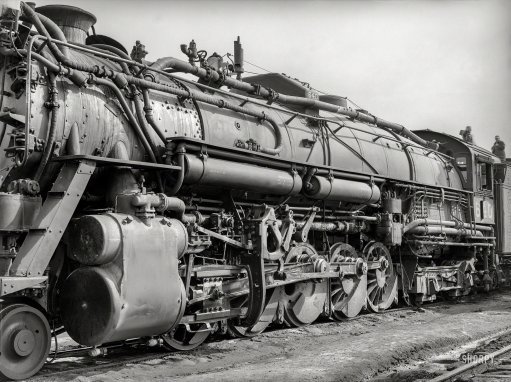
The Locomotion: 1940 March 1940. "Passenger locomotive while in the yard at Big Spring, Texas." Medium format negative by Russell Lee for the FSA. View full size.
0 notes
Text
Cultura e o turismo da Lapa, estão em festa!
New Post has been published on https://www.izazilli.com/2017/06/28/cultura-e-o-turismo-da-lapa-estao-em-festa/
Cultura e o turismo da Lapa, estão em festa!
A estação ferroviária da Lapa, que completará 65 anos de sua inauguração oficial, no próximo dia 2 de julho, tem muita história para contar… De sues dias de glória como modal de transporte, como protagonista do primeiro turismo férreo no Brasil, como palco das memoráveis chegadas de “Maria Fumaça”, mas também pelo abandono, luta por sua recuperação ( quase concluída) e pelo que abrigará no futuro breve.
Todas essas histórias serão lembradas e contadas no dia 3 de julho, as 10H00, no Receptivo turístico da histórica cidade, onde uma exposição fotográfica, formada com acervo pessoal de pessoas da comunidade vai traçar um perfil de um dos prédios mais queridos pelos lapeanos. Neste dia será apresentado o projeto do Centro de Memória Ferroviária, que terá a “Estação Nova ” como sede e o programa Ecotrenzinho de educação ambiental. As 11H00, haverá uma visita técnica nas obras quase concluídas do prédio.
Comemoração dos 65 anos da Estação Ferroviária da Lapa
Quando: dia 3 de julho às 10H00
Onde: no receptivo turístico da Lapa, com visita técnica as 11H00
Apresentação do Centro de memória e projeto Ecotrenzinho
Um pouco da história:
Quando a linha original, construída pela Estrada de Ferro Paraná ( chegou a Lapa em 1891) , foi retificada no inicio dos anos 50 , as estações antigas do trecho, foram fechadas. Na Lapa inicialmente se construiu uma provisória de madeira e em 2 de julho de 1952, a “Estação Nova”, era inaugurada. O trafego naquela época era intenso pois fazia parte do ramal Curitiba-São Francisco do Sul ( porto), onde finalizava a jurisdição da RVPSC- REDE VIAÇÃO PARANÁ – SANTA CATARINA. Já o movimento maior de passageiros era em direção a Curitiba e há infindáveis relatos de horas de espera na Estação de Engenheiro Bley ( ainda no município da Lapa), pela demora do trem que vinha do Norte ( São Paulo/Norte do Paraná) e tinha prioridade sobre a composição que ia da Lapa, na passagem pelo entroncamento.
Em 1957 ( há 60 anos) é criada a RFF/SA – Rede Ferroviária Federal – Sociedade Anônima e as autônomas são extintas e passam a ser regionais da Rede de âmbito federal. A RVPSC, por exemplo tornou-se SR/5.
Com o transporte ferroviário de passageiros sendo tratado como algo secundário a Rede vai lentamente desativando as linhas com esse fim e priorizando o transporte de carga. A SR/5 sempre produtiva, se destacava no cenário nacional.
Em 1983 , por iniciativa de empresários e gestores de turismo de municípios do Paraná e Santa Catarina, dos quais se destacam Francisco Canola Teixeira de Pomerode Luis Eduardo Nunes da Costa de Jaraguá do Sul e Marcio Assad da Lapa, criou-se uma parceria com a RFF/SA, para o lançamento e operação do primeiro turismo Férreo do Brasil. Uma viagem de 9 dias saindo de Curitiba com paradas nos municípios do trecho, onde os turistas eram recebidos com muita festa em clima típico. Na Lapa, por exemplo, pessoas caracterizados de época aliados a tropeiros e músicos animavam as chegadas e partidas. O trajeto tinha como destino parcial São Francisco do Sul e de lá , o ônibus que acompanhava todo o roteiro levava os “ferroturistas” a Caiobá e nos dias seguintes a Paranaguá , onde subiam a serra pela história estrada inaugurada em 1885 ( há 132 anos). Em fevereiro 1986, o turismo férreo no auge de sua performance e fama , ganhava também uma atração de peso, dando a estação ferroviária da Lapa, seus dias mais gloriosos. Duas composições puxadas por “Maria Fumaça” modelos MIKADO , prefixos 155 e 157, fabricadas pela American Locomotive Company, faziam um dos maiores eventos já registrados na cidade, onde em torno de cinco mil pessoas lotavam toda a região da estação para saudar a chegada de 560 turistas, 280 em cada trem. A partir daí semanalmente a estação passou a ser semanalmente palco de extraordinários eventos, onde as famílias da cidade iam em peso nas chegadas e partidas, que eram animadas pela banda Maestro João Francisco Mariano. Foram inúmeras chegadas de Papai Noel, Coelho da pascoa, figuras como “Zé Gotinha” e artistas performáticos, que protagonizaram momentos felizes.Tudo foi muito bem até meados dos anos 90 , quando o processo de privatização começa a interferir na rotina das viagens, findando-as, totalmente na transição para a FSA, Ferrovia Sul Atlântico, empresa privada, que recebeu a concessão. A estação é fechada, considerada não operacional pela empresa, que abandona o imóvel a própria sorte: arrombado, pilhado( pois ainda continha móveis, documentos, cofre, relógio e outros utensílios), na sequencia até mesmo tentativa de incêndio foi registrado. Um grupo de lapeanos se mobilizou para tentar intervir em favor da preservação do prédio, mas, a indefinição entre a empresa e órgãos governamentais impediram uma solução definitiva de uso. Em 1999, diante de uma situação de calamidade, onde o local já estava servindo de abrigo de mendigos e usuários de drogas, o município conseguiu realizar ( com grande resistência da ALL – América Latina Logística, a empresa que sucedeu a FSA) uma viagem promocional em 13 de junho, aniversário do município. Nesta data se fez um frágil e provisório acordo para que uma escola ( Colégio Cooperativa da Lapa) utiliza-se o local, que estava completamente descaracterizado em seu interior quase totalmente demolido. Nessa época por iniciativa da Associação Brasileira de Preservação Ferroviária, que tinha um lapeano como diretor de comunicação o Lapeano Márcio Assad, requereu o tombamento do edifício que foi homologado em 2001, pelo patrimônio histórico estadual.
Com a medida voltou a esperança na comunidade na recuperação daquele espaço tão querido por todos… Mas a indefinição de posse e domínio faz a situação se arrastar e o prédio sofre um novo golpe: Um vagão com a porta aberta “varre ” a plataforma semi destruindo a gare e afeta totalmente o telhado. Seriamente avariada e sem a escola utilizando o espaço o local volta a ser frequentado por marginais e se torna cenário de crime.
Ano passado , o município e o Exercito Brasileiro firmam acordo e inicia-se a recuperação. Este ano é definido a utilização do mesmo como sede do Centro de memória Ferroviária, onde abrigará, também o Museu da Imagem e Som e o projeto de Educação Ambiental Ecotrenzinho, que será fruto de uma parceria entre órgãos da administração pública municipal e instituições de ensino.
Assim a comunidade lapeana terá de volta um dos espaços turístico-culturais, mais importantes de seu acervo.
Baixe Nosso aplicativo para Android: https://goo.gl/4VxWhE
0 notes
Photo
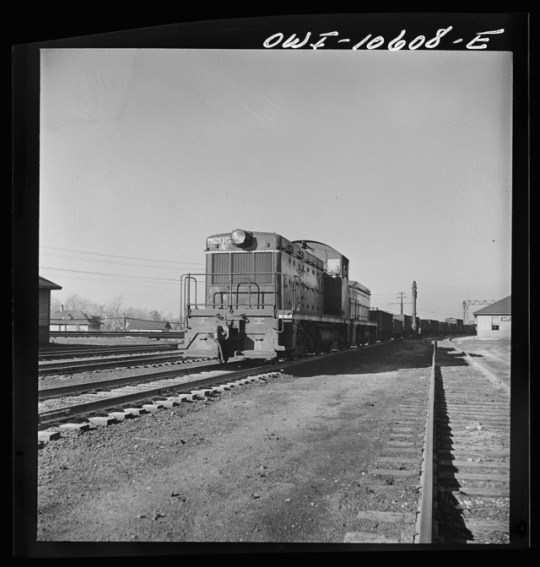
Chicago, Illinois. One of the giant diesel-electric locomotives at work at an Illinois Central Railroad yard. Nov 1942
Jack Delano
Farm Security Administration - Office of War Information Photograph Collection (Library of Congress)
2 notes
·
View notes
Photo

Chicago, Illinois. Locomotives loading up with coal, water, and sand at an Illinois Central Railroad yard before going out on the road, Nov. 1942
Jack Delano
Farm Security Administration - Office of War Information Photograph Collection (Library of Congress)
9 notes
·
View notes
Photo

Chicago, Illinois. Locomotives over the ash pit at the roundhouse and coaling station at the Chicago and Northwestern Railroad yards. Dec 1942
Jack Delano
Farm Security Administration - Office of War Information Photograph Collection (Library of Congress)
8 notes
·
View notes
Photo

Chicago, Illinois. In the Chicago and Northwestern Railroad locomotive repair shops Dec 1942
Jack Delano
Farm Security Administration - Office of War Information Photograph Collection (Library of Congress)
6 notes
·
View notes
Photo
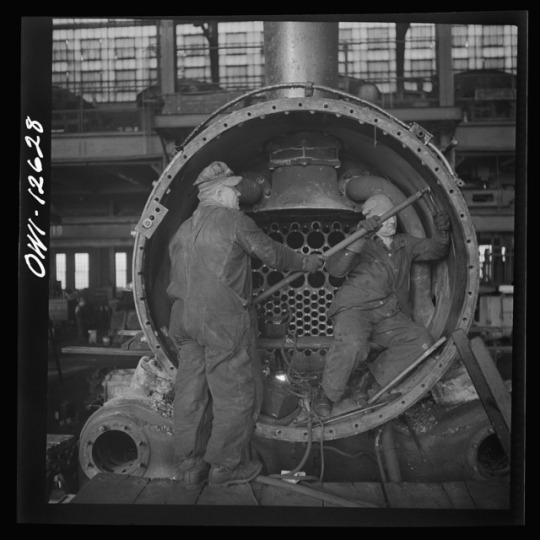
Chicago, Illinois. Working on a locomotive at the Chicago and Northwestern Railroad repair shops Dec 1942
Jack Delano
Farm Security Administration - Office of War Information Photograph Collection (Library of Congress)
4 notes
·
View notes
Photo

Chicago, Illinois. Working on a locomotive at the Chicago and Northwestern Railroad Dec 1942
Jack Delano
Farm Security Administration - Office of War Information Photograph Collection (Library of Congress)
3 notes
·
View notes
